Deciphering the history behind Soviet-era plaques in Zhytomyr
This wasn’t supposed to be a long post. Kirsty and I saw these Soviet-era symbols on the side of the PJSC Ukrtelecom (Ukrainian National Telecommunications Operator) building while wandering around Zhytomyr. We liked them and decided to photograph them.
Originally, I thought that was all I could say about them. Not surprisingly, nothing comes up in an Internet search and there was no one locally that I could talk to in the hope of gleaning more information. But, on closer inspection, and delving a little deeper into the history of Zhytomyr (*) and postal and communication services in Ukraine, I’ve come up with a few theories as to what most of them represent.
(*) We’ve already written about Zhytomyr, including a brief description of the city, its location and what there is to see and do etc., in a previous post so I won’t repeat our comments here.
For want of a better word, I’m going to call them commemorative plaques. I’m sure this isn’t the right word to describe them but they aren’t monuments and they certainly aren’t mosaics, which you still see quite a few of in Ukraine as well as other countries that originally were part of the USSR.
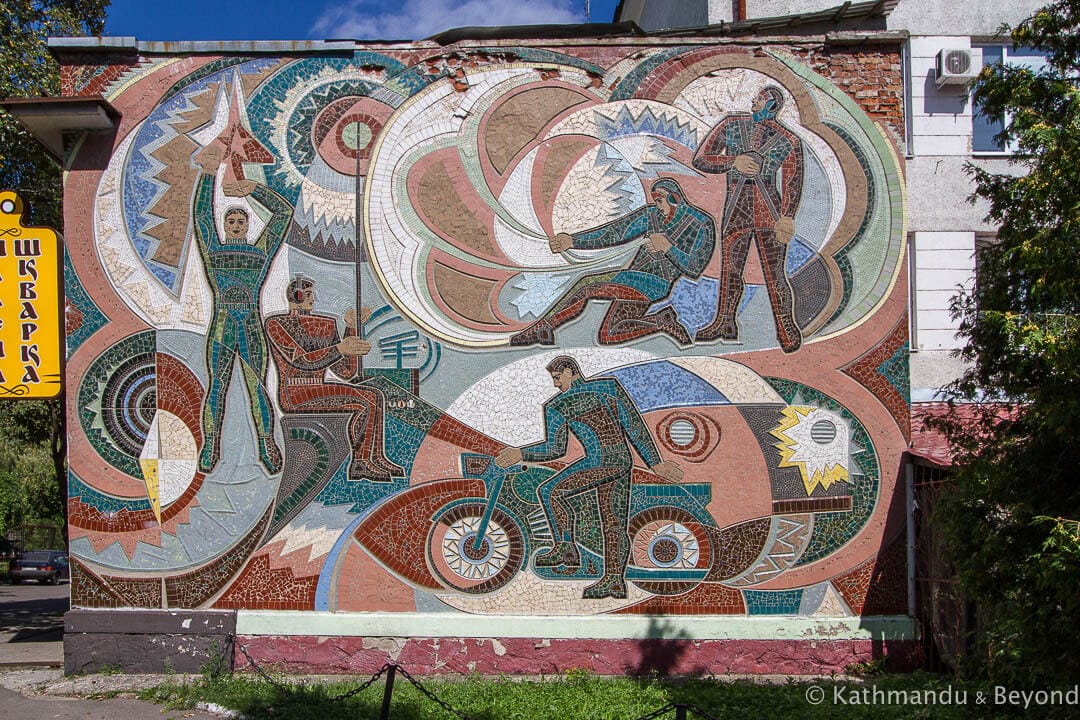
Typical mosaic (this one is on the side of the Driving School of the Civil Defence Organisation in Lutsk, Ukraine)
There are nine commemorative plaques in total, all in a line along the side of the PJSC Ukrtelecom building and, to the bemusement of passers-by and people standing at a nearby bus stop, I dutifully photographed each one of them.
What I omitted to do, however, was to photograph the entire building in order to put the plaques into perspective. The building was, after all, fairly unremarkable but I’ve snagged this image from Google maps to show that the plaques are actually quite big, something that doesn’t come across in the individual photos.
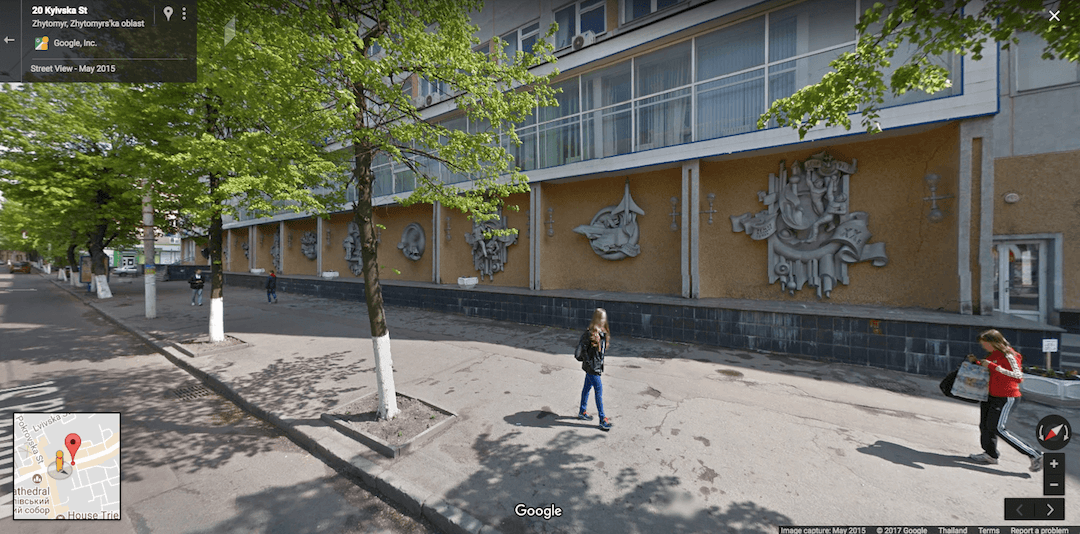
Ukrtelecom building in Zhytomyr
So, here are my theories on what some of the plaques represent:
Commemorative plaque 1
The Soviet Rocket engineer, Sergei Korolev, was born in Zhytomyr. He was a leading figure during the Space Race between the USSR and the Americans in the 1950s and ’60s. I believe this plaque commemorates his achievements, and the achievements of the USSR in those early years of space exploration. The two cosmonauts, clasping hands and reaching for the stars symbolise the quest to put a man into space. The words on the left of the plaque translate as “Earth”, “Space” and “Communication”. Those on the right say “Peace”. As an aside, if you do intend to go to Zhytomyr, the Korolyov Cosmonaut Museum, which is named in his honour, is full of retro space-age mementoes and definitely worth a visit. We’ve written about our visit here.
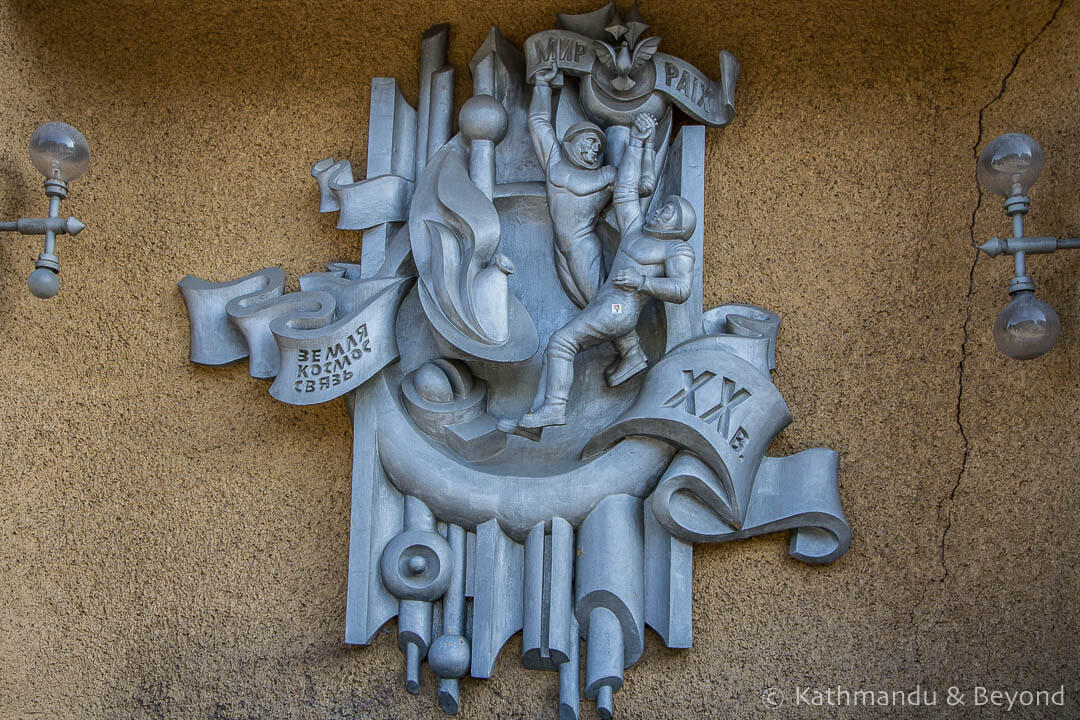
Plaque 1
Commemorative plaques 2, 4 and 6.
Three of the plaques, namely 2, 4 and 6, depict various past and present modes of postal-service transportation. Plaque 2 shows a high-speed aircraft (*), a freight carrier, and a postal van, and also something that looks like an early version of a mobile phone. Mobile phones date back to 1973 (Motorola) so it is feasible. The words bottom-right translate as “Communication” and the Cyrillic version of “USSR”, Union of Soviet Socialist Republic.
(*) I originally thought that the high-speed aircraft (the one pointing upwards) may have had something to do with Ozerne Airbase, a once-secret military base 11km southeast of Zhytomyr that played a strategic role in the Cold War.
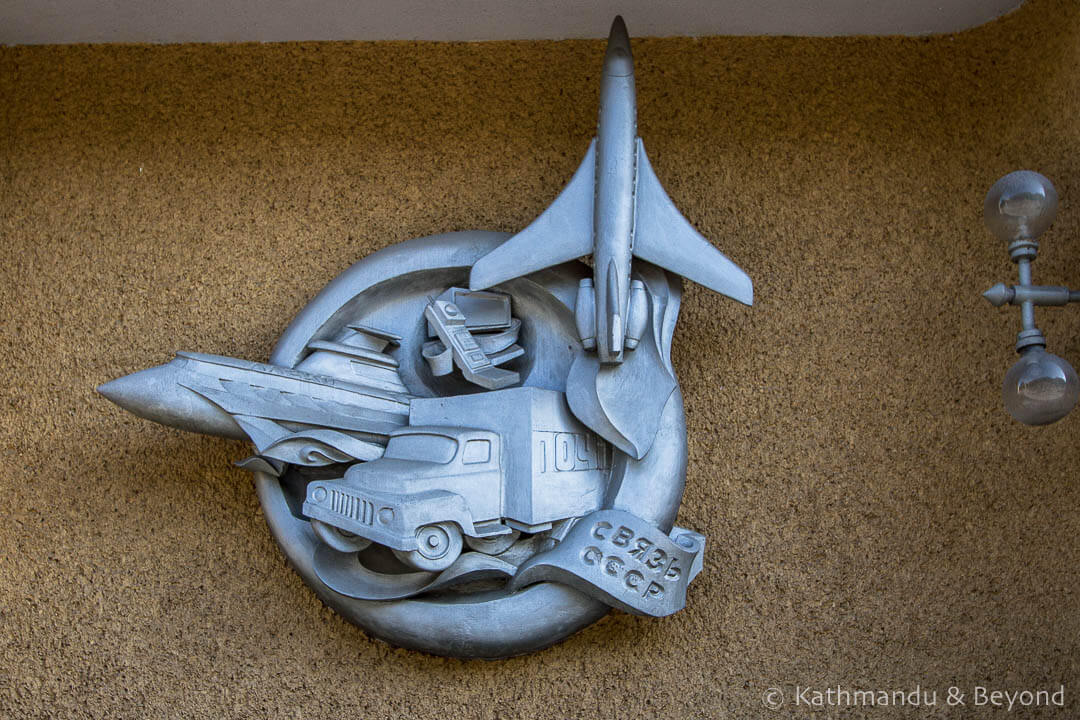
Plaque 2
As well as depicting an earlier postal-service van, with “Post” written on the side, and some early telephone equipment, plaque 4 shows what is now the PJSC Ukrtelecom building. The antiquated telephone is also a giveaway. Back then presumably it would have been known as the telecommunications building (or, no doubt, by some grand Soviet name – the Soviets liked their grand titles!). The words on the right translate as “Post Office 1934” so I’m assuming that the date 1934 relates to the building’s original construction and inauguration.
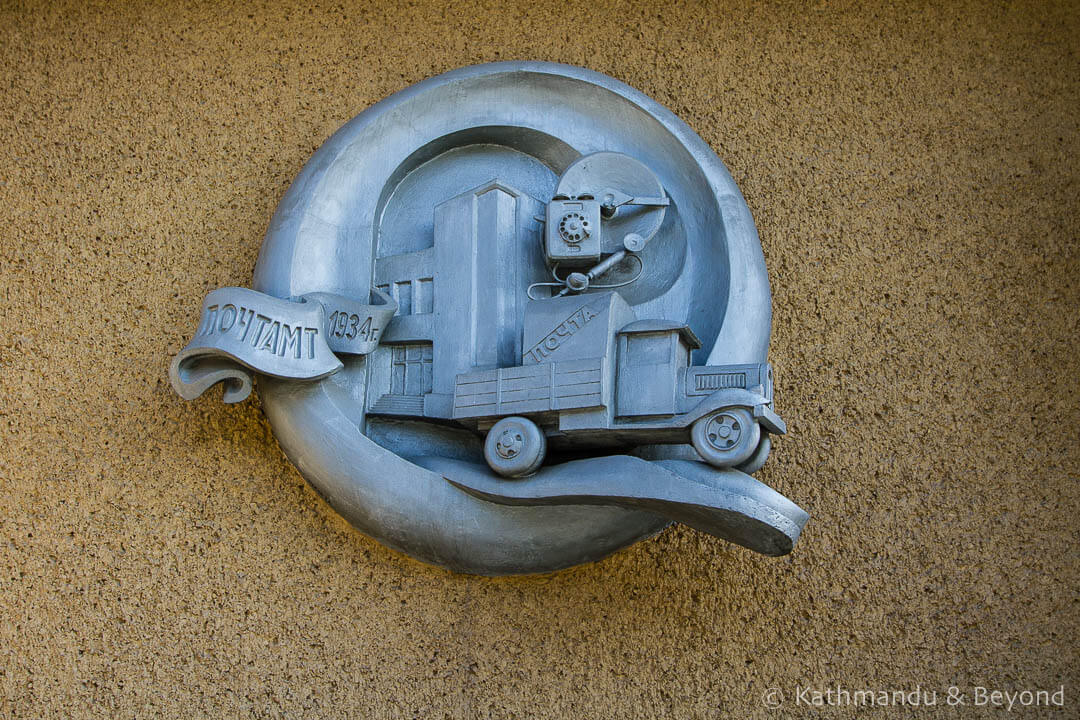
Plaque 4
Plaque 6 took a bit of detective work but I discovered that 1865, the date on the plaque underneath the postal van, was the year Russia started using what are called Zemstvo postal stamps in rural areas, including Ukraine. During this period, the world was upgrading to stamped postal services (Britain introduced the famous Penny Black in 1840). The plaque depicts very early (19th century) postal carriers – a paddle steamer, a steam train, and a postal van complete with a horn-blowing man seated in a rear dicky seat – plus the words “telephone” and “telegraph”. In other words, this plaque is all about the 1865 start of Ukraine’s postal service.
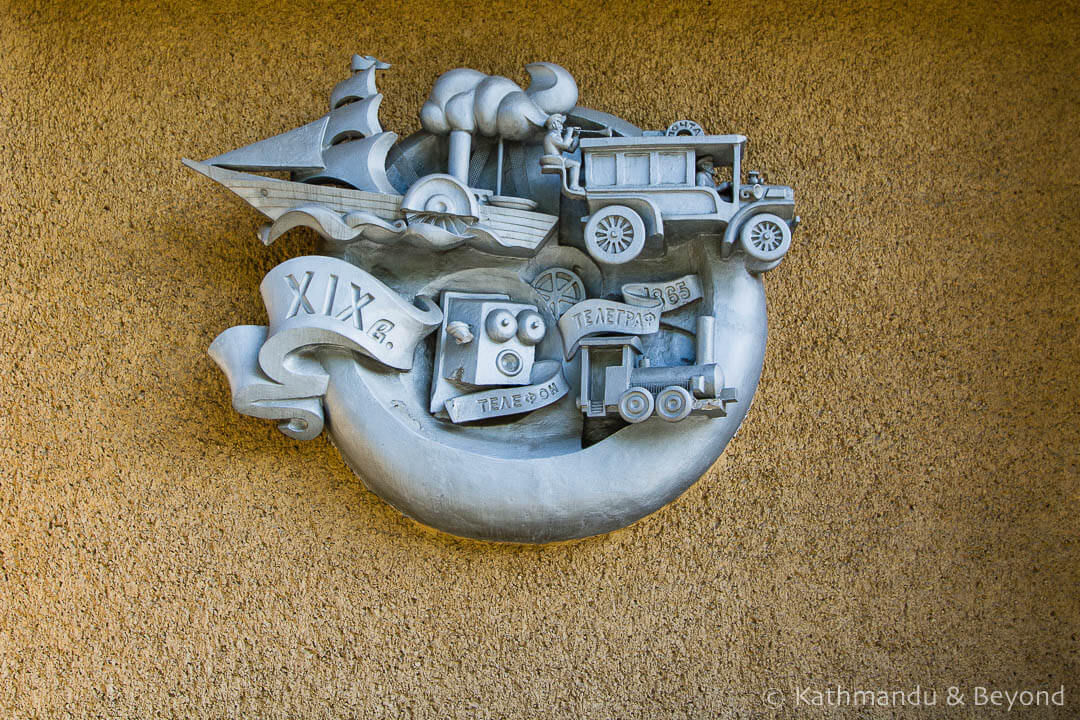
Plaque 6
Commemorative plaque 3
Because of the 1941, 1945 dates and the Russian word for “Victory” (top right), it is obvious that plaque number 3 commemorates the Second World War (or the Great Patriotic War as it is more commonly known in this part of the world (*).
(*) Technically, in Ukraine, World War II is known as the Second World War because the Ukrainian government replaced the term Great Patriotic War with Second World War as part of their 2015 decommunization laws.
In the top left of the plaque can be seen the opening lines of a patriotic Russian WW2 song known as The Sacred War. The words read “Arise great country”.
It is also interesting to note that this plaque is damaged (all three soldiers have parts of their body missing (*)). Whether this was deliberate or down to age/wear and tear is not something I can answer. But, given that there is also a degree of damage on plaques 5, 8 and 9, I would suspect that the damage is down to the elements rather than targeted vandalism.
(*) Initially, I thought there were only two soldiers but there is a third body behind the main soldier on the left-hand side.
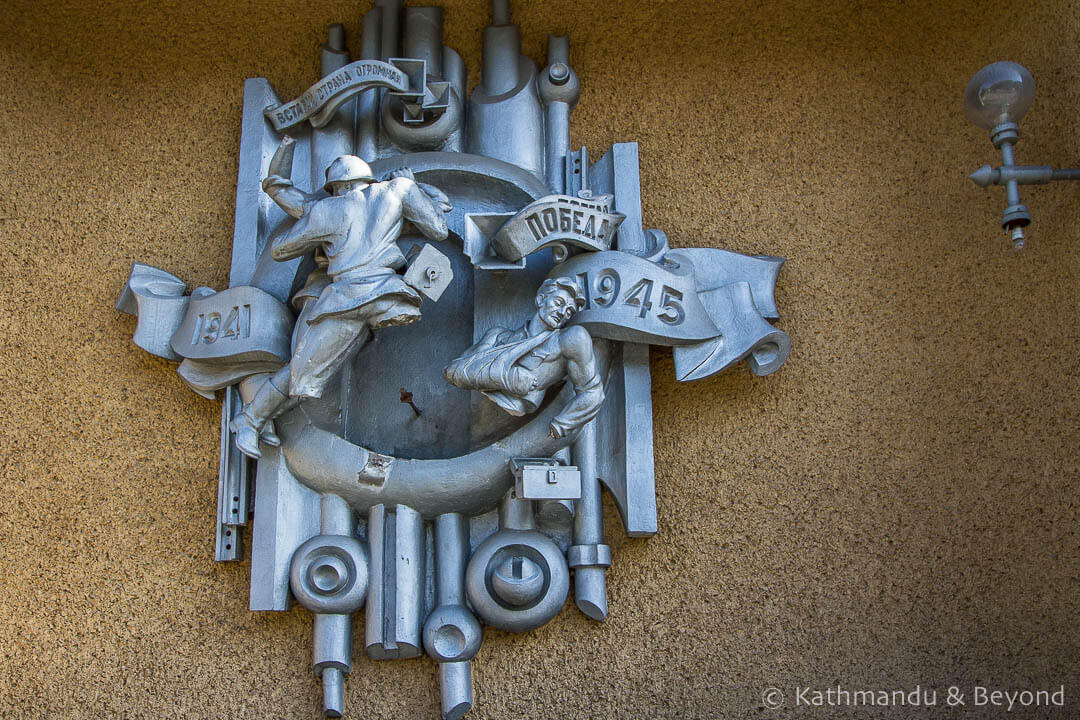
Plaque 3
Commemorative plaque 5
Zhytomyr became the capital of a briefly independent Ukraine in 1918. This didn’t last for long though as the Bolsheviks overran the city (along with most of central and eastern Ukraine) in 1919 and by 1920 it was well and truly under the control of the Soviets. I am assuming, mainly because of the date but also because the uniform is typical of the Red Army around this period, that plaque 5 celebrates the city’s (and Ukraine’s) liberation by the Soviets.
The barely-discernible words underneath the image of the building read “Commander Shchors”. Nikolay Shchors was a famous soldier in the Red Army during the Russian Civil War. He served in Ukraine in 1918-19.
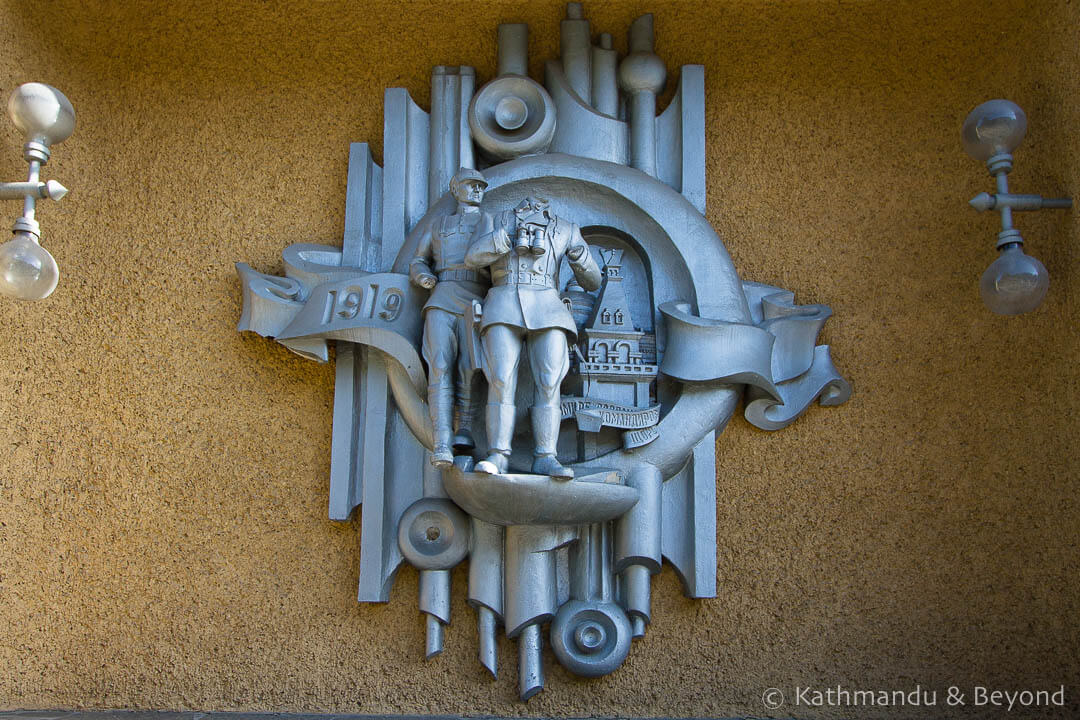
Plaque 5
Commemorative plaque 7
Going back further in history, Zhytomyr was captured and razed to the ground by Zaporozhian Cossacks in 1648. The man holding a torch above his head in plaque 7 looks decidedly Cossack in appearance to me and I’m fairly certain that a reference to that time is being depicted here. The Roman numerals XVII (17th century) is also another clue.
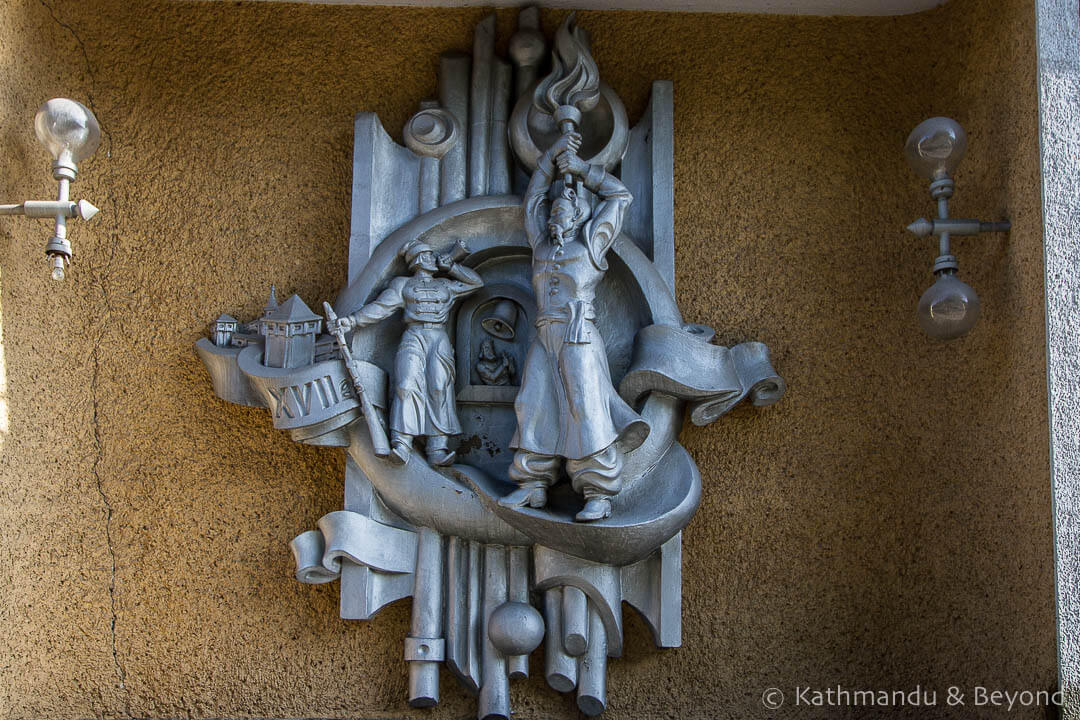
Plaque 7
Commemorative plaque 8 and 9
I can’t pinpoint a tangible reference on either of these plaques. Clearly, they illustrate a time in Zhytomyr’s early history but I’m not sure of the exact reference of either. The original settlement was sacked by the Mongols in the mid-13th century but there is no obvious clue that either plaque is alluding to that. The Roman numerals on plaque 8 suggest something noteworthy happened in the 14th and 15th century, while plaque 9 makes reference to the 11th century. With the latter, this could possibly be referring to Kievan Rus’ (Old Russia), a federation of East Slavic tribes that was at the height of its glory during the first half of the 11th century under the reign of Yaroslav the Wise (1019-1054).
If anyone has any further information or theories, I would be grateful to hear from you.
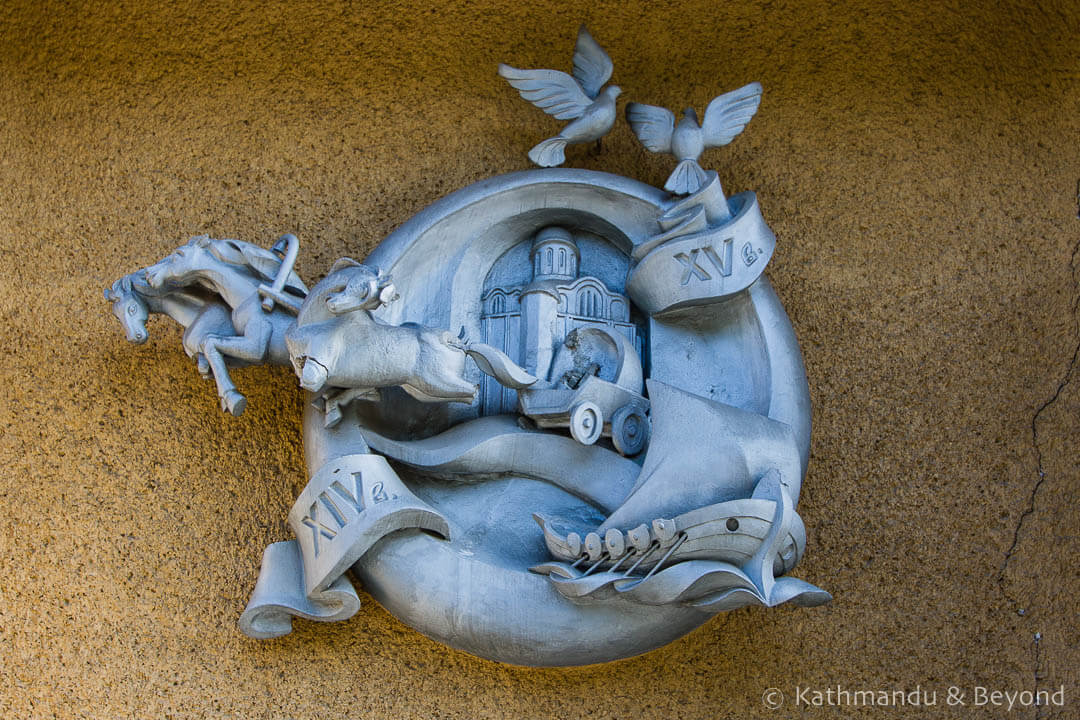
Plaque 8
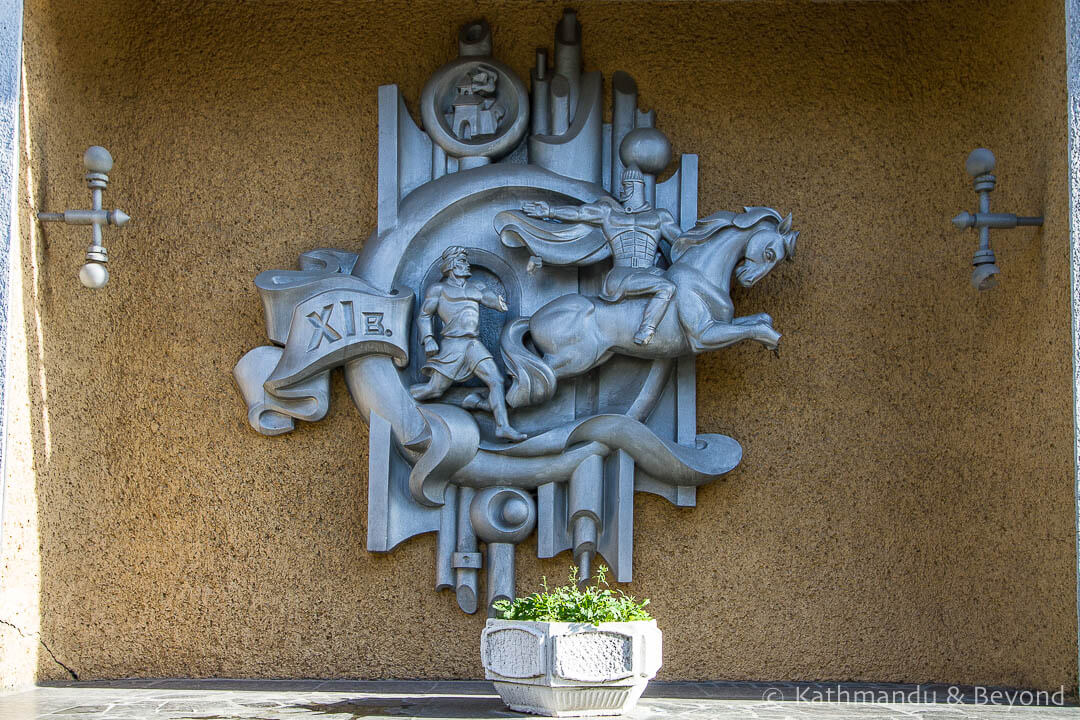
Plaque 9
So that’s my take on what these, in my opinion, interesting plaques refer to. I’ve enjoyed piecing this post together and having the challenge of finding out information and making assumptions without having them handed to me on a plate (i.e. looking them up on the Internet!). I am grateful for my dad’s assistance, whom I asked for a second opinion (he likes puzzles and piecing information together). I am also thankful to his next-door neighbour, Jenya, who speaks Russian and translated the wording on the plaques for me.
I’m sure I’ve bored most of you senseless by now but if you can’t have a bit of self-indulgence on your own blog then where can you have it, so no apology from me I’m afraid!
Locating the plaques
Finding the PJSC Ukrtelecom premises and these commemorative plaques is easy. The building is located a short walk from Sobornyi Maidan, Zhytomyr’s very Soviet-looking main square and also close to the Hotel Ukraine (Ukrainia), which is another of the city’s landmarks. The exact coordinates are 50.257076, 28.665838.
READ MORE POSTS FEATURING UKRAINE
INSPIRED BY THIS UNCONVENTIONAL FORM OF SOVIET-ERA STREET ART IN UKRAINE? PIN THIS…
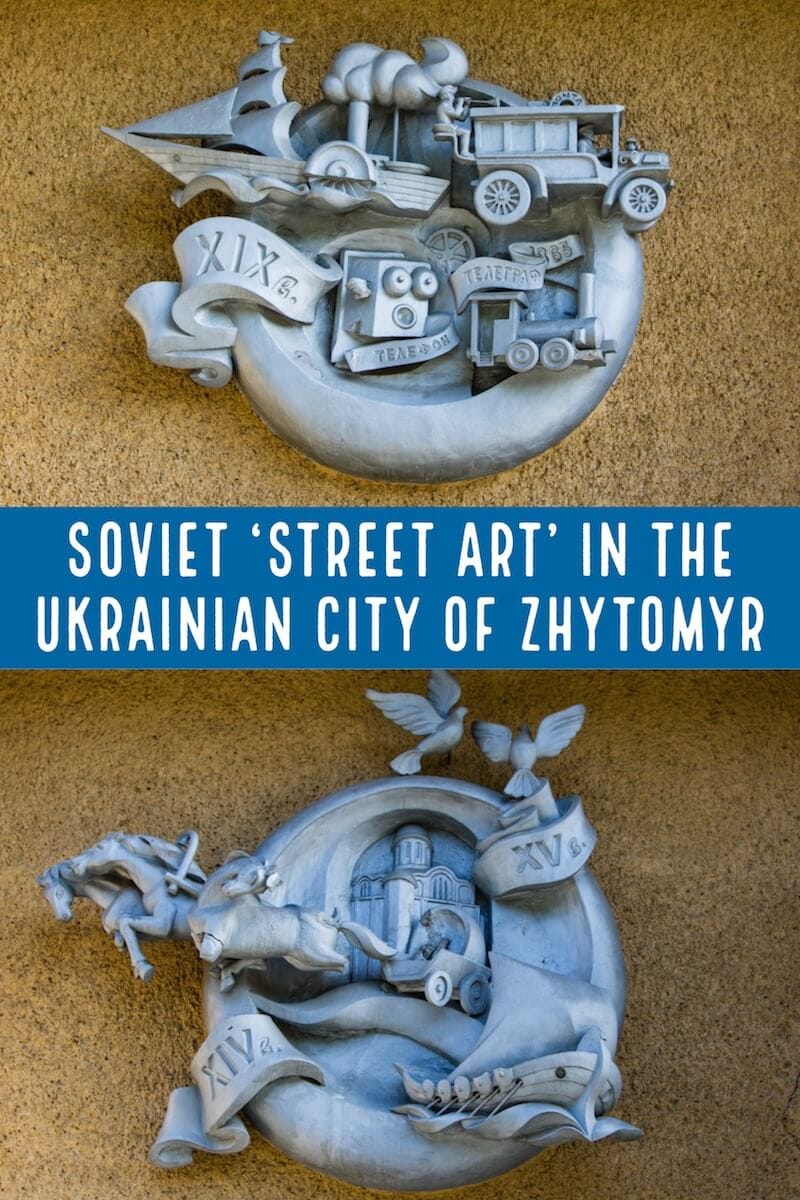
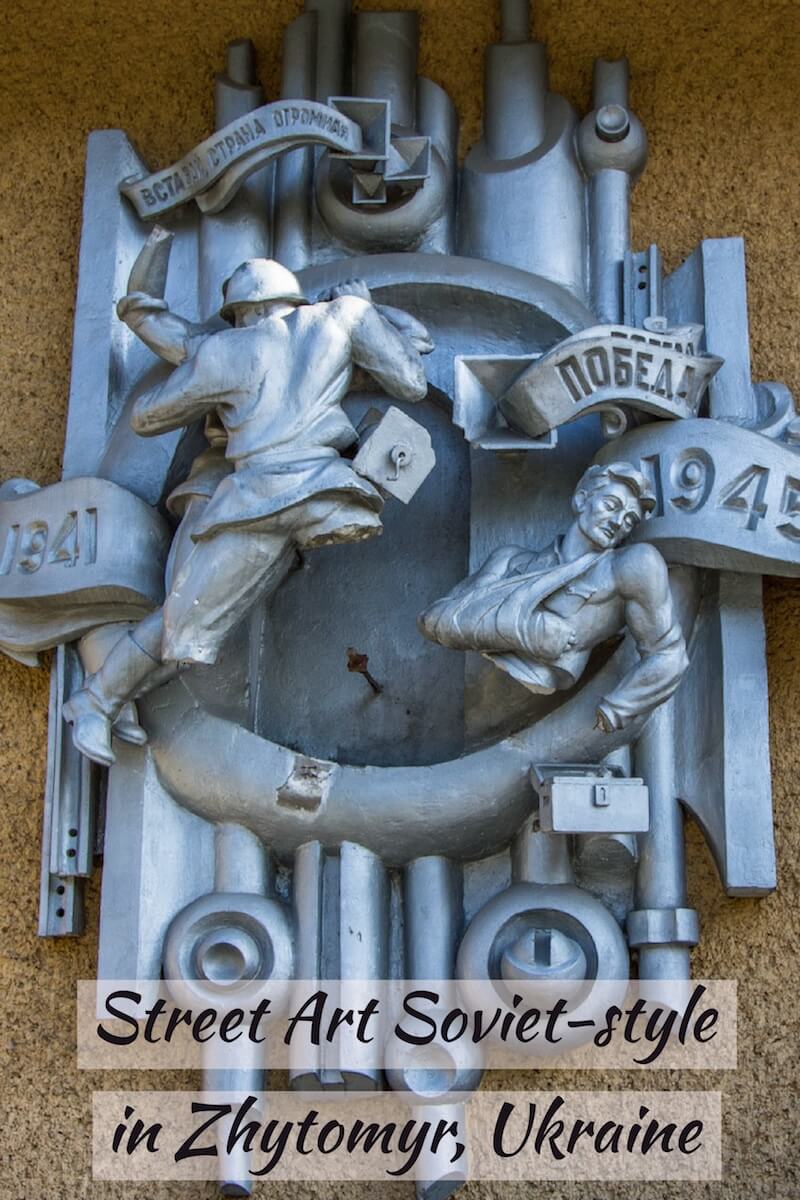

Totally digging the picture of 2 cosmonauts clasping hands. Brilliant. I recall the arms raise vividly. Even though I was a wee lad LOL….Reagan, Gorbachev, Cold War, posturing. Always on edge, like you knew not if nuclear war would break out the following day. Pretty scary, and that edge dissolved with glasnost. Loving these pictures. Thanks for sharing with us 🙂
Ryan
Thanks, Ryan. I’m like you, I recall all the names (Reagan, Gorbachev, Cold War etc.) and was aware that something was going on but I certainly wasn’t aware of the seriousness back then. Ukraine is full of little gems like this, it’s why we are planning yet another visit back in the not-so-distant future!
Finding treasures like this is one of my favorites. I love how you pieced together what they may mean. I would have been asking everyone who walked by, I’m curious like that:) The mosaic one is my favorite.
Finding things like this also help us harmoniously combine our respective passions for street art and all things Soviet-era!